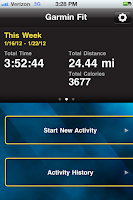Do you remember what the Internet was like in 2004? America was evenly split between those who used broadband and those who still "dialed up." Facebook was still just a bunch of Harvard students. YouTube didn't even exist.
But there was this brand-spanking new technology called . . . podcasting.
I remember in those early days, scouring the web for interesting podcasts. At some point, though, my interest died, and for years, the thought of listening to podcasts never flitted through my mind. Until last weekend. I was headed out for a long run (2-1/4 hours) and I wanted something to listen to. But I was tired of the same music over and over. Somehow, I started looking for podcasts. Once my iPod was loaded up, I hit the road.
After an hour of boning up on some current events, I switched over to The New Yorker's fiction podcasts. Holy crap! The New Yorker has a huge archive of short stories that been published in the magazine at some point in the past, being read by other famous authors. Now normally, I'd rather read a story myself than hear someone else read it, but what a way to pass the time when you've settled into a long-distance pace. My favorite was listening to Ben Marcus read "A Village After Dark," an older story by Kazuo Ishiguro. Just outstanding. I also very much enjoyed David Means reading "Chef's House" by Raymond Carver.
On future runs, I am looking forward to hearing some short stories by Denis Johnson, James Salter, John O'Hara, and perhaps even some authors I am not yet familiar with.
Do you listen to anything other than music on your runs? If so, what do you enjoy?
Related posts:
Running and Listening to Music
But there was this brand-spanking new technology called . . . podcasting.
I remember in those early days, scouring the web for interesting podcasts. At some point, though, my interest died, and for years, the thought of listening to podcasts never flitted through my mind. Until last weekend. I was headed out for a long run (2-1/4 hours) and I wanted something to listen to. But I was tired of the same music over and over. Somehow, I started looking for podcasts. Once my iPod was loaded up, I hit the road.
After an hour of boning up on some current events, I switched over to The New Yorker's fiction podcasts. Holy crap! The New Yorker has a huge archive of short stories that been published in the magazine at some point in the past, being read by other famous authors. Now normally, I'd rather read a story myself than hear someone else read it, but what a way to pass the time when you've settled into a long-distance pace. My favorite was listening to Ben Marcus read "A Village After Dark," an older story by Kazuo Ishiguro. Just outstanding. I also very much enjoyed David Means reading "Chef's House" by Raymond Carver.
On future runs, I am looking forward to hearing some short stories by Denis Johnson, James Salter, John O'Hara, and perhaps even some authors I am not yet familiar with.
Do you listen to anything other than music on your runs? If so, what do you enjoy?
Related posts:
Running and Listening to Music









